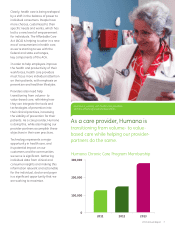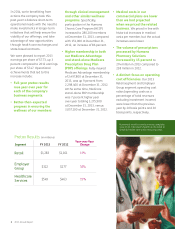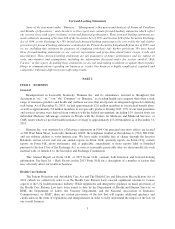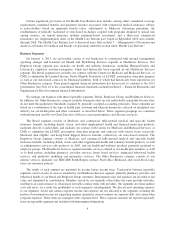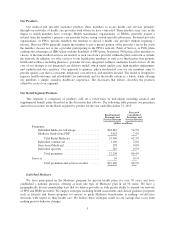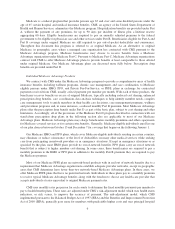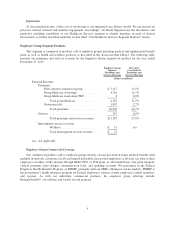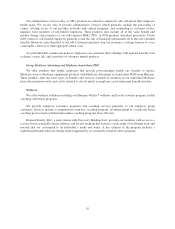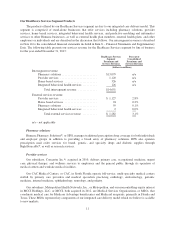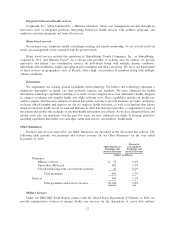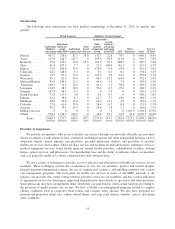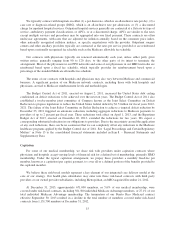Humana 2013 Annual Report Download - page 16
Download and view the complete annual report
Please find page 16 of the 2013 Humana annual report below. You can navigate through the pages in the report by either clicking on the pages listed below, or by using the keyword search tool below to find specific information within the annual report.Medicare is a federal program that provides persons age 65 and over and some disabled persons under the
age of 65 certain hospital and medical insurance benefits. CMS, an agency of the United States Department of
Health and Human Services, administers the Medicare program. Hospitalization benefits are provided under Part
A, without the payment of any premium, for up to 90 days per incident of illness plus a lifetime reserve
aggregating 60 days. Eligible beneficiaries are required to pay an annually adjusted premium to the federal
government to be eligible for physician care and other services under Part B. Beneficiaries eligible for Part A and
Part B coverage under original Medicare are still required to pay out-of-pocket deductibles and coinsurance.
Throughout this document this program is referred to as original Medicare. As an alternative to original
Medicare, in geographic areas where a managed care organization has contracted with CMS pursuant to the
Medicare Advantage program, Medicare beneficiaries may choose to receive benefits from a Medicare
Advantage organization under Medicare Part C. Pursuant to Medicare Part C, Medicare Advantage organizations
contract with CMS to offer Medicare Advantage plans to provide benefits at least comparable to those offered
under original Medicare. Our Medicare Advantage plans are discussed more fully below. Prescription drug
benefits are provided under Part D.
Individual Medicare Advantage Products
We contract with CMS under the Medicare Advantage program to provide a comprehensive array of health
insurance benefits, including wellness programs, chronic care management, and care coordination, to Medicare
eligible persons under HMO, PPO, and Private Fee-For-Service, or PFFS, plans in exchange for contractual
payments received from CMS, usually a fixed payment per member per month. With each of these products, the
beneficiary receives benefits in excess of original Medicare, typically including reduced cost sharing, enhanced
prescription drug benefits, care coordination, data analysis techniques to help identify member needs, complex
case management, tools to guide members in their health care decisions, care management programs, wellness
and prevention programs and, in some instances, a reduced monthly Part B premium. Most Medicare Advantage
plans offer the prescription drug benefit under Part D as part of the basic plan, subject to cost sharing and other
limitations. Accordingly, all of the provisions of the Medicare Part D program described in connection with our
stand-alone prescription drug plans in the following section also are applicable to most of our Medicare
Advantage plans. Medicare Advantage plans may charge beneficiaries monthly premiums and other copayments
for Medicare-covered services or for certain extra benefits. Generally, Medicare-eligible individuals enroll in one
of our plan choices between October 15 and December 7 for coverage that begins on the following January 1.
Our Medicare HMO and PPO plans, which cover Medicare-eligible individuals residing in certain counties,
may eliminate or reduce coinsurance or the level of deductibles on many other medical services while seeking
care from participating in-network providers or in emergency situations. Except in emergency situations or as
specified by the plan, most HMO plans provide no out-of-network benefits. PPO plans carry an out-of network
benefit that is subject to higher member cost-sharing. In some cases, these beneficiaries are required to pay a
monthly premium to the HMO or PPO plan in addition to the monthly Part B premium they are required to pay
the Medicare program.
Most of our Medicare PFFS plans are network-based products with in and out of network benefits due to a
requirement that Medicare Advantage organizations establish adequate provider networks, except in geographic
areas that CMS determines have fewer than two network-based Medicare Advantage plans. In these areas, we
offer Medicare PFFS plans that have no preferred network. Individuals in these plans pay us a monthly premium
to receive typical Medicare Advantage benefits along with the freedom to choose any health care provider that
accepts individuals at rates equivalent to original Medicare payment rates.
CMS uses monthly rates per person for each county to determine the fixed monthly payments per member to
pay to health benefit plans. These rates are adjusted under CMS’s risk-adjustment model which uses health status
indicators, or risk scores, to improve the accuracy of payment. The risk-adjustment model, which CMS
implemented pursuant to the Balanced Budget Act of 1997 (BBA) and the Benefits and Improvement Protection
Act of 2000 (BIPA), generally pays more for members with predictably higher costs and uses principal hospital
6



